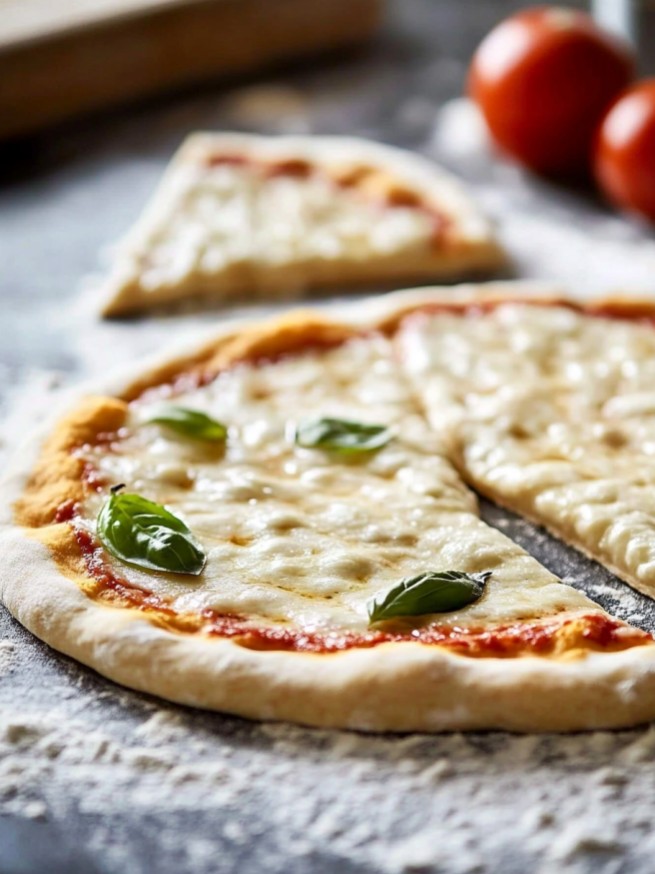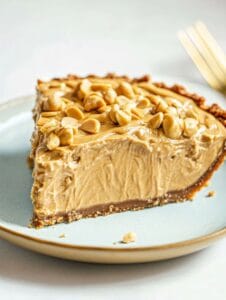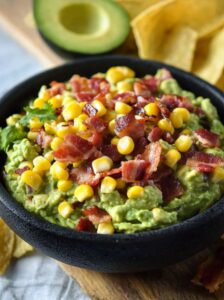Making pizza at home can be a rewarding way to enjoy a classic favorite tailored to your taste. This easy homemade pizza dough gives you a reliable base for all types of toppings, ready in a fraction of the time of delivery.
- Cuisine: Italian
- Prep Time: 1 hour
- Cook Time: 10 minutes
- Total Time: 1 hour and 10 minutes
- Servings: 2 medium pizzas
Here’s a great video that shows the process of making easy pizza dough.
Why You’ll Love This Recipe
-
Amazingly Simple: With just six basic ingredients you likely already have, this recipe is straightforward and perfect for first-time bread makers.
-
No Fancy Equipment Needed: You can achieve a fantastic, springy dough with just a bowl, a spoon, and your hands. No stand mixer is required.
-
Better Than Delivery: The flavor and texture of homemade crust are far superior to any takeout. You get a soft, chewy crust with a satisfyingly crisp edge.
-
Completely Customizable: This dough is the perfect blank canvas. You can adjust the thickness, add herbs for extra flavor, or even make it ahead for a quick weeknight meal.
-
Fun and Rewarding: There’s a special satisfaction in creating a delicious pizza from scratch. It’s a fun activity for the whole family to get involved in.

Ingredients
-
1 cup (240ml) warm water (110-115°F / 43-46°C): This is the most crucial element for activating the yeast. Too cold, and the yeast won’t wake up; too hot, and you’ll kill it. It should feel like warm bathwater to the touch.
-
1 (.25 ounce) package active dry yeast (about 2 ¼ teaspoons): This is the leavening agent that makes the dough rise, creating an airy, puffy crust. Instant yeast can also be used.
-
1 teaspoon white sugar: This is food for the yeast. It helps it activate and multiply quickly, ensuring a good rise. You can substitute with honey or maple syrup if preferred.
-
2 ½ cups (300g) bread flour, plus more for dusting: Bread flour has a higher protein content than all-purpose flour, which helps develop strong gluten strands. This results in a chewier, more structured crust. All-purpose flour can be used, but the crust will be slightly softer.
-
2 tablespoons olive oil, plus more for the bowl: Olive oil adds wonderful flavor, helps to tenderize the dough, and keeps it from drying out.
-
1 teaspoon salt: Salt is essential for flavor and also strengthens the gluten structure, making the dough more elastic.
How to Make It
Step 1: Activate (or “Proof”) the Yeast
In a large mixing bowl, pour in the warm water. Sprinkle the yeast and sugar over the water and give it a gentle stir. Let the mixture sit for 5-10 minutes. You’ll know the yeast is active when the mixture becomes frothy and bubbly. If you don’t see this activity, your yeast may be expired, and you should start over with a fresh packet.
Step 2: Form and Knead the Dough
Once the yeast is foamy, add the olive oil, salt, and 2 ½ cups of bread flour to the bowl. Stir with a spoon or spatula until a shaggy, sticky dough begins to form.
Turn the dough out onto a lightly floured surface. Knead the dough for 6-8 minutes. To knead, push the dough away from you with the heel of your hand, then fold it over, give it a quarter turn, and repeat. The dough is ready when it’s smooth, elastic, and springs back when you poke it gently. If it’s too sticky during kneading, add a little more flour, one tablespoon at a time.
Step 3: Let the Dough Rise
Lightly oil the inside of your mixing bowl and place the ball of dough inside. Turn it over once to coat the top with oil, which prevents a dry “skin” from forming. Cover the bowl with a damp cloth or plastic wrap.
Place the bowl in a warm, draft-free spot to rise for about 1 to 1.5 hours, or until it has doubled in size. A good spot is inside an oven with the light on (but the heat off).
Step 4: Shape and Bake
Once the dough has doubled, gently press down on it to release the trapped air. Transfer it to a lightly floured surface and divide it in half to make two pizza bases.
Let the dough balls rest for 10 minutes. This step, called “relaxing the dough,” makes it much easier to roll or stretch without it shrinking back.
Preheat your oven to its highest setting, typically 475-500°F (245-260°C). If you have a pizza stone, place it in the oven to preheat as well.
Roll or stretch each dough ball to your desired thickness. Place it on a piece of parchment paper or a lightly floured pizza peel. Add your favorite sauce and toppings, then slide the pizza (with the parchment) onto the hot pizza stone or a baking sheet. Bake for 8-12 minutes, or until the crust is golden brown and the cheese is melted and bubbly.
Tips for Success
Weigh Your Flour: For the most accurate results, use a kitchen scale to measure your flour.
Don’t Rush the Rise: Giving the dough the full time to rise is key to developing its flavor and texture.
Hot Oven is Key: A very hot oven helps create a crispy crust and mimics a professional pizza oven.
Go Easy on Toppings: Overloading your pizza can lead to a soggy crust.
For a Crispier Crust: Use a preheated pizza stone or an inverted baking sheet. The direct, intense heat helps crisp up the bottom.
Recipe FAQs
Can I make this dough ahead of time?
Yes, after the first rise, you can punch the dough down, wrap it tightly in plastic wrap, and refrigerate it for up to 3 days. This process, called cold fermentation, can actually enhance the flavor. Let the dough sit at room temperature for about 30 minutes before shaping.
Can I freeze the pizza dough?
Absolutely. After the first rise, punch the dough down, coat it lightly with olive oil, and place it in a freezer-safe zip-top bag. It can be frozen for up to 3 months. To use, thaw it in the refrigerator overnight and then let it rest on the counter for 30 minutes before shaping.
Why is my dough so tough and hard to roll out?
This usually happens when the gluten is too tense. It means the dough needs to relax more. Cover it and let it rest on the counter for another 10-15 minutes, and it should become much more pliable. Overworking the dough without letting it rest can also cause toughness.
What should I do if my dough didn’t rise?
This is almost always a yeast issue. Either your yeast was old, or the water was too hot or too cold. Ensure your water is at the correct temperature (110-115°F) and that your yeast hasn’t expired.

Make Pizza Dough at Home Easily
Ingredients
- 1 cup Warm Water
- 1 Package Active Dry Yeast
- 1 tsp White Sugar
- 2 ½ cup Bread Flour
- 2 tbsp Olive Oil
- 1 tsp Salt
Instructions
- In a large mixing bowl, pour in the warm water. Sprinkle the yeast and sugar over the water and give it a gentle stir. Let the mixture sit for 5-10 minutes. You’ll know the yeast is active when the mixture becomes frothy and bubbly. If you don’t see this activity, your yeast may be expired, and you should start over with a fresh packet.
- Once the yeast is foamy, add the olive oil, salt, and 2 ½ cups of bread flour to the bowl. Stir with a spoon or spatula until a shaggy, sticky dough begins to form.Turn the dough out onto a lightly floured surface. Knead the dough for 6-8 minutes. To knead, push the dough away from you with the heel of your hand, then fold it over, give it a quarter turn, and repeat. The dough is ready when it’s smooth, elastic, and springs back when you poke it gently. If it’s too sticky during kneading, add a little more flour, one tablespoon at a time.
- Lightly oil the inside of your mixing bowl and place the ball of dough inside. Turn it over once to coat the top with oil, which prevents a dry “skin” from forming. Cover the bowl with a damp cloth or plastic wrap.Place the bowl in a warm, draft-free spot to rise for about 1 to 1.5 hours, or until it has doubled in size. A good spot is inside an oven with the light on (but the heat off).
- Once the dough has doubled, gently press down on it to release the trapped air. Transfer it to a lightly floured surface and divide it in half to make two pizza bases.Let the dough balls rest for 10 minutes. This step, called “relaxing the dough,” makes it much easier to roll or stretch without it shrinking back.Preheat your oven to its highest setting, typically 475-500°F (245-260°C). If you have a pizza stone, place it in the oven to preheat as well.Roll or stretch each dough ball to your desired thickness. Place it on a piece of parchment paper or a lightly floured pizza peel. Add your favorite sauce and toppings, then slide the pizza (with the parchment) onto the hot pizza stone or a baking sheet. Bake for 8-12 minutes, or until the crust is golden brown and the cheese is melted and bubbly.







Hey Sandra Clare, can i use almond flour insted of regular flour for this recipe?
I tried with almond flour, gotta adjust the liquid cuz it absorbs more, but works fine!
what if my dough rises and then flies away, do i chase it?
I always mess up activating the yeast. Does the water temp really make or break it? Mine never bubbles.
love the step by step, makes it so easy to follow even in my chaos kitchen, thanks Sandra!
Totally agree! My kids could even help with this one!
Tried this recipe. Not impressed. Found better ones out there.
great, now if only my oven would cooperate and actually heat up, that’d be cool.
Does anyone know if I can substitute the flour with a gluten-free mix? Will the measurements be the same?
imagine using this dough for a giant pizza. that’d be epic!
Why let it rise just once? Double proofing makes it even fluffier. Anyone else tries that?
This turned out great! My family loved it. Thanks for sharing 🙂
how to make the bottom of the bread crispy? mine always soft.
Love the recipe! Made it with a sweet twist. Added cinnamon and sugar!
Actually, the perfect temp for yeast activation is between 105°F and 110°F. Too hot and it dies.
Let me guess, another recipe that ‘anyone can make’ but turns out mediocre at best?
bread making is my new hobby and this recipe? chef’s kiss! so good and easy!
can i make this in a dorm microwave tho?
Followed this to the letter and it was a disaster. Nothing works as written.
if i add chocolate chunks, does it become dessert bread or breakfast? asking for a friend.
Tried this with vegan substitutes and it turned out perfect. Great recipe!
actually made this without burning it. miracle.
Wonder if I could program a robot to do this for me. Hmm.
Actually, a slow fermentation process might develop flavors better. Ever tried an overnight rise in the fridge?
For achieving a flakier crust, would laminating the dough with butter help or hinder the process?
throwing in some jalapenos next time, gonna make it a spicy bread!